Today, on Meteca’s blog, we are going to talk about IoT as it is applied in the health sector, thanks to the support of an article published in peerbits.com.
The health sector, today more than ever, is facing a time of great difficulty. The world’s population, in fact, is ageing; the diseases we face are increasing disproportionately; the cost of health care is soaring, risking becoming dangerously elitist and leaving out a significant portion of the global population.
These and other considerations are depressing and promise catastrophic scenarios. But what if technology could come to the aid of health care? The increasingly concrete development of IoT apps is an important ally in cutting costs and facilitating certain practices. While it is true that technology cannot prevent the population from ageing, it is also true that it can facilitate (both in economic and accessibility terms) the provision of certain health benefits – making care home-centric rather than hospital-centric.
There are many applications of IoT in healthcare – applications that can, in fact, make life easier for everyone. Here are some of them.
Reporting and monitoring
Monitoring a patient’s medical condition in real time allows continuous control of his vital functions and can literally save his life in case of sudden illness – heart failure, diabetes, asthma attacks, etc. – all that is needed is a simple app on a smartphone, which is in turn connected to a medical device, to record the patient’s data and communicate it in real time to the emergency services.
End-to-end Connectivity and Affordability
The IoT comes to the aid not only of patients, but also of professionals. Thanks to internet connectivity, it is possible to have information exchange, machine-to-machine communication, and transfer of data in seconds. Thanks to the aforementioned data, it is also possible to spot errors and to modify therapies and treatments while they are underway. This feature of the Iot allows a significant reduction in healthcare costs, as it drastically cuts the number of unnecessary medical examinations.
Data Analysis
The amount of data collected in the healthcare sector is impressive. Thanks to its digital nature, the IoT is able to analyze medical data in real time, without the need to store it.
Notifications
An alert notification in case of sudden and worrying changes in the patient’s health condition can save his life. Medical sector IoT devices collect vital data and can transfer it in real time to doctors and rescue workers. Thanks to the warning notifications, medical professionals can intervene quickly to assist those in difficulty.
Remote medical assistance
Thanks to IoT apps, patients are able to contact a doctor even though they may be miles away. With remote medical assistance, doctors can assist patients as they have all the vital data at their fingertips. This also alleviates the hospitals’ workload, as they have fewer patients to treat and can, therefore, focus on the most urgent and serious cases.
Research
The data collected through IoT technology makes a huge contribution to research – using patients’ medical data to make progress. The collected data can, accordingly, be used to carry out statistical studies to support medical research.
Alongside the advantages listed above, however, there are serious challenges to face, but these we will discuss in a future article. To learn more and for further information about Meteca, please do not hesitate to contact us.
